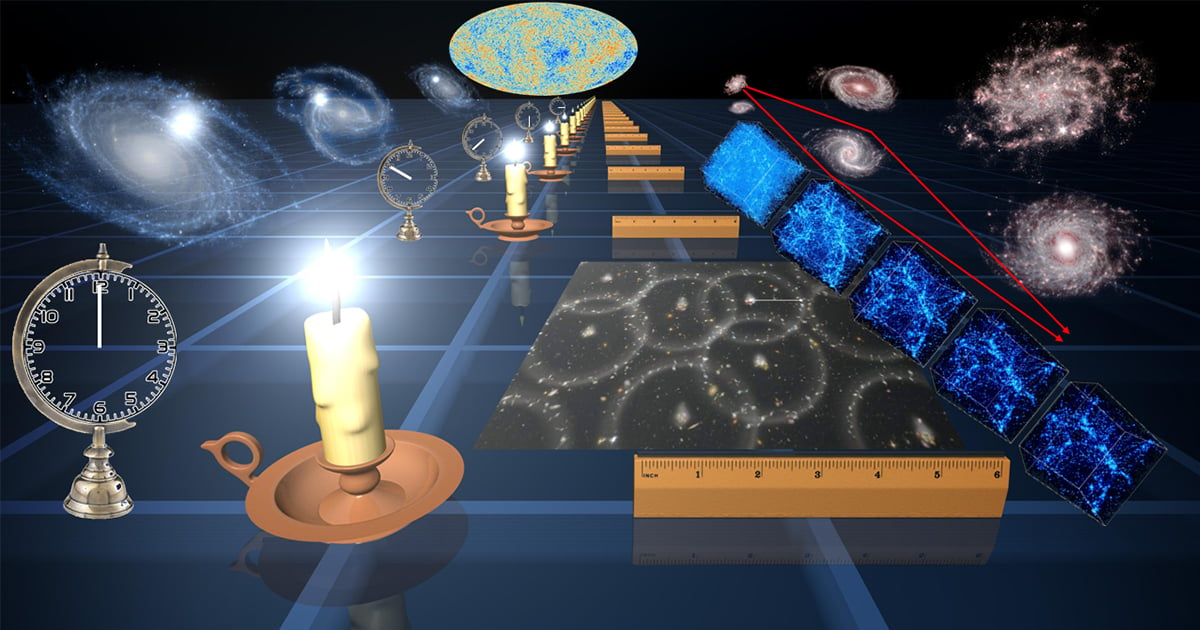- 3.8Impact Factor
- 6.3CiteScore
- 24 daysTime to First Decision
Theoretical and Observational Approaches to the Hubble Tension in Cosmology
Special Issue Information
Dear Colleagues,
Cosmology is currently in a crisis known as the Hubble tension, where the redshifts of extragalactic objects increase with distance about 10% faster than expected in the standard cosmological model (ΛCDM) with parameters calibrated to fit the pattern of anisotropies in the cosmic microwave background (CMB). This Special Issue aims to provide a platform for researchers to share the latest updates on theoretical and observational approaches to the Hubble tension, especially including researchers who present their work at the related parallel session of the National Astronomy Meeting 2025 in Durham, UK (https://conference.astro.dur.ac.uk/event/7/program). Recent observational advances allow distances to be measured in several ways beyond the traditional route using supernovae calibrated by the Leavitt law of Cepheid variable stars, a technique which has continued to see steady improvements in precision and more thorough cross-checks for systematics. The cosmic expansion history can also be constrained using, e.g., baryon acoustic oscillations (BAOs) as standard rulers and stellar populations as cosmic clocks. This latter approach has made significant strides in recent years, both using the absolute ages of galactic stars as a lower limit on the cosmic age, and using the differential ages of stars in passive galaxies at two different redshifts to estimate the time difference between those redshifts. An important aim of this Special Issue is to exploit the increasing sensitivity of various techniques to give readers an idea of which ones actually show a tension with the ΛCDM. This will give a deeper insight into the origin of the Hubble tension. Various proposals have been put forward, for instance, that distances are underestimated in the local Universe, or that the expansion rate is genuinely faster than expected. This would normally invalidate fits to the CMB anisotropies, but new physics prior to recombination could potentially avoid this issue. The expansion history can also be modified at late times, perhaps due to a changing dark energy density—as hinted at by some observations. The solution might even preserve the standard ΛCDM expansion history at all epochs, but involve redshifts being inflated in the nearby Universe by a large local void, merely giving the illusion of a Hubble tension. This Special Issue provides an opportunity to discuss the latest refinements to these approaches and a clearer assessment of their viability in light of observational advances. In this respect, we particularly welcome contributions that combine the latest evidence to argue against previously proposed solutions that may have been viable until recently.
Dr. Indranil Banik
Dr. Harry Desmond
Guest Editors
Manuscript Submission Information
Manuscripts should be submitted online at www.mdpi.com by registering and logging in to this website. Once you are registered, click here to go to the submission form. Manuscripts can be submitted until the deadline. All submissions that pass pre-check are peer-reviewed. Accepted papers will be published continuously in the journal (as soon as accepted) and will be listed together on the special issue website. Research articles, review articles as well as short communications are invited. For planned papers, a title and short abstract (about 250 words) can be sent to the Editorial Office for assessment.
Submitted manuscripts should not have been published previously, nor be under consideration for publication elsewhere (except conference proceedings papers). All manuscripts are thoroughly refereed through a single-blind peer-review process. A guide for authors and other relevant information for submission of manuscripts is available on the Instructions for Authors page. Galaxies is an international peer-reviewed open access semimonthly journal published by MDPI.
Please visit the Instructions for Authors page before submitting a manuscript. The Article Processing Charge (APC) for publication in this open access journal is 1400 CHF (Swiss Francs). Submitted papers should be well formatted and use good English. Authors may use MDPI's English editing service prior to publication or during author revisions.
Keywords
- cosmology
- distance scale
- supernovae
- galaxies
- variable stars
- stellar populations
- recombination

Benefits of Publishing in a Special Issue
- Ease of navigation: Grouping papers by topic helps scholars navigate broad scope journals more efficiently.
- Greater discoverability: Special Issues support the reach and impact of scientific research. Articles in Special Issues are more discoverable and cited more frequently.
- Expansion of research network: Special Issues facilitate connections among authors, fostering scientific collaborations.
- External promotion: Articles in Special Issues are often promoted through the journal's social media, increasing their visibility.
- e-Book format: Special Issues with more than 10 articles can be published as dedicated e-books, ensuring wide and rapid dissemination.

